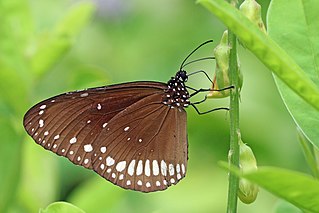
Euploea core, also known as the common crow, is a common butterfly found in South Asia to Australia. In India it is also sometimes referred to as the common Indian crow, and in Australia as the Australian crow. It belongs to the crows and tigers subfamily Danainae.
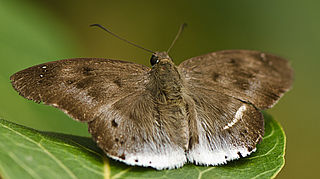
Tagiades japetus, commonly known as the pied flat or the common snow flat, is a species of spread-winged skipper butterfly belonging to the family Hesperiidae. It is widely distributed, being found from India, the Himalayas, Southeast Asia, to Australia. It contains several recognized subspecies.

Euploea sylvester, the double-branded crow, also known as the two-brand crow in Australia, is a butterfly found in South Asia, Southeast Asia and parts of Australia that belongs to the crows and tigers, that is, the danaid group of the brush-footed butterflies family.

Papilio fuscus, the Canopus swallowtail, is a butterfly of the family Papilionidae, that is found on Timor, northern Australia, and New Guinea.

Papilio aegeus, the orchard swallowtail butterfly or large citrus butterfly is a species of butterfly from the family Papilionidae, that is found in eastern Australia and Papua New Guinea.

Euploea is a genus of milkweed butterflies. The species are generally dark in coloration, often quite blackish, for which reason they are commonly called crows. As usual for their subfamily, they are poisonous due to feeding on milkweeds and other toxic plants as caterpillars. The latter are aposematically colored to warn off predators from eating them, and the adult butterflies are often mimicked by unrelated species which are not or less poisonous.

Apaturina is a monotypic genus of butterflies in the family Nymphalidae. Its sole species is Apaturina erminea, the turquoise emperor.

Hoya australis, commonly known as the waxvine or common waxflower, is one of the species in the genus Hoya. It is a vine found on rainforest margins and rocky areas, and occurs in eastern and northern Australia, from Western Australia, through the Northern Territory and coastal Queensland from Cape York to northern New South Wales. It is a popular garden plant, noted for its fragrant flowers.

Ficus obliqua, commonly known as the small-leaved fig, is a tree in the family Moraceae, native to eastern Australia, New Guinea, eastern Indonesia to Sulawesi and islands in the southwestern Pacific Ocean. Previously known for many years as Ficus eugenioides, it is a banyan of the genus Ficus, which contains around 750 species worldwide in warm climates, including the edible fig. Beginning life as a seedling, which grows on other plants (epiphyte) or on rocks (lithophyte), F. obliqua can grow to 60 m (200 ft) high and nearly as wide with a pale grey buttressed trunk, and glossy green leaves.

Zizina labradus, the common grass blue, grass blue, or clover blue, is a small Australian butterfly of the family Lycaenidae.
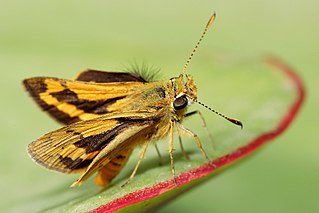
Ocybadistes walkeri, the greenish grass-dart, green grass-dart, southern dart or yellow-banded dart, is a type of butterfly known as a skipper found in eastern and southern Australia, with one subspecies found in the Northern Territory.

The Mascarene crow is a species of Nymphalidae butterfly in the Danainae subfamily. It is found in Mauritius and Réunion.

Hesperilla ornata, also known as the spotted skipper or spotted sedge-skipper, is a species of butterfly in the family Hesperiidae. It is found along the non-tropical eastern seaboard of mainland Australia and in the adjacent mountain ranges.
Toxidia inornata, is a butterfly of the family Hesperiidae. The common name for this species is spotless grass-skipper or inornata skipper. It is found in Indonesia, New Guinea, Australia's Cape York and surrounding islands.
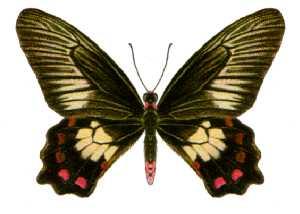
Pachliopta polydorus, the red-bodied swallowtail, is a butterfly from the family Papilionidae found in north-eastern Queensland, Australia and Papua New Guinea.
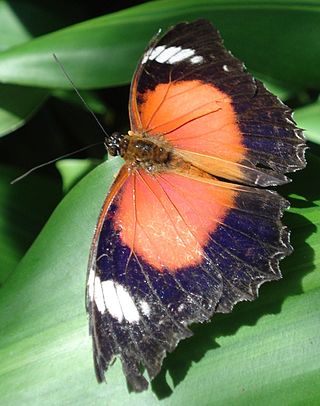
Cethosia cydippe, the eastern red lacewing, is a species of butterfly from Australia, New Guinea and nearby islands. The Australian subspecies, C. c. chrysippe, is known as the red lacewing butterfly.
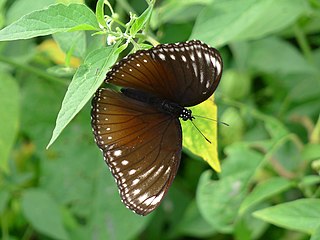
Hypolimnas anomala, commonly known as the Malayan eggfly or crow eggfly, is a species of eggfly.

Euploea phaenareta, the giant crow is a butterfly in the family Nymphalidae. It was described by Johann Gottlieb Schaller in 1785. It is found in the Indomalayan realm and the Australasian realm.

Euploea modesta, the plain blue crow, is a butterfly in the family Nymphalidae. It was described by Arthur Gardiner Butler in 1866. It is found in the Indomalayan realm and the Australasian realm.



















